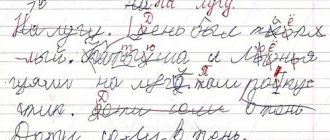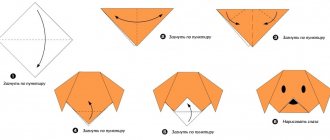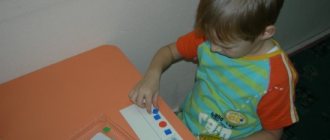Today, more and more children are experiencing difficulties with the school curriculum. One of the supposed root causes of school failure is dysgraphia - a violation of written speech. Writing and reading are the basis and means for further successful learning and for correcting written speech. To prevent the occurrence of such problems even at school age, it is necessary to conduct preventive classes in preschool age to eliminate the pathology of phonemic perception, violation of language analysis and synthesis, as well as the syllabic structure of the word.
How can dysgraphia be expressed at an early age?
What you need to pay attention to by the age of four years of child development:
- on how the baby speaks: does he pronounce the sounds correctly, are there any omissions of syllables, for example “motolok” instead of “hammer”, or increases their number - “komanata” - “room”, rearranges them “devore” - “tree”, not distinguishes hissing sounds from whistling sounds "siska" - "bump", does not distinguish between the sounds l-r - "kaltina" - "picture", replacing sounds in the syllables "gebemot" - "hippopotamus", inserts consonants into the syllable "orange" - "orange" ", swaps sounds "nisichka" - "titmouse".
- Does the baby coordinate different parts of speech with each other when composing phrases and sentences? He should not make such mistakes as, for example, “many plates”, “near the table”, “candy is on the table”, “drinking from a glass”.
- only if children do not use words in conversation, but know their meaning or use them correctly, for example, “bottom” - “stand”, “window” - “window sill”.
- Do they make mistakes in the names of young animals, for example, “pig - piggy, little pig”, “cow - bulls”.
- the fact that the baby has a poor vocabulary; if he does not understand the lexical meaning of what he is talking about.
- to the fact that children’s stories show incorrect changes in endings (many “dogs”, “bear cubs”, “roads”), nouns do not agree with adjectives (“dog’s nose”, “fur hat”, “rabbit’s ear”).
- the fact that the baby does not know enough general concepts, knows “toys”, “clothes”; does not distinguish domestic animals from wild ones, does not distinguish vegetables from fruits.
If you have discovered at least one of the above signs of your child’s incipient dysgraphia, these are already the first calls to contact a specialist.
A child at the age of seven , when he masters writing skills, hears and pronounces words to himself, but misses letters and syllables in their writing, “writes” letters incorrectly, distorts them - these are the first signs of future dysgraphia. In the absence of organized, regular assistance from experts who understand the root causes of speech pathology, these defects cannot be eliminated.
Dysgraphia: general information
Dysgraphia is a writing disorder that involves crooked letter writing with multiple misspellings of words. The handwriting of a child with this disorder is illegible, and words may be written in reverse with a large number of grammatical errors. This defect is a consequence of disruption of certain parts of the brain.
Writing impairment, the causes of which lie in the improper functioning of certain parts of the brain, occurs in many children who are beginning to learn the basics of writing. Thus, among second grade students, on average, such a violation occurs in more than half of the class. In the absence of timely treatment, such a deviation entails a decrease in the child’s self-esteem, affects his academic performance, and affects relationships with peers.
Dysgraphia is often accompanied by minor problems with the speech apparatus. This violation has several types and is classified according to severity.
How to deal with child dysgraphia?
Correcting written language disorders is a complex problem. The efficiency of its solution directly depends on the ability to sensibly combine the help of a speech therapist with the correction by a psychologist of the processes of cognition of the surrounding world, the education of graphomotor skills and concepts of space and time in young students. Timely speech therapy work will prevent and solve problems for the child’s future full life, in adapting to school, in understanding the world around him and socializing in society. Remember that “patience and work will grind everything down”, “the true pointer is not a fist, but a caress.”
Review of methods for diagnosing and correcting written speech disorders in primary schoolchildren
Review of diagnostic and correction methods
impairments of written speech in primary schoolchildren
Dysgraphia is a partial, specific disorder of the writing process in which persistent and repeated errors are observed.
Writing disorders (dysgraphia) in children of primary school age have been studied for a long time, but even now this is one of the most pressing problems in speech therapy, since dysgraphia is one of the most common forms of speech pathology in primary schoolchildren.
Writing disorders affect the entire learning process and speech development of children. Timely identification of these violations will have a positive impact on the development of speech therapy work with students.
The first task when diagnosing the state of writing skills in primary schoolchildren is to clarify the nature of the difficulties and the degree of lag in these skills. The question must also be resolved whether the lag in writing skills is due to insufficient mental development or has an independent genesis, and this directly depends on the results of a clinical and psychological study of the child’s mental development. Diagnosing intelligence is the second task.
Kornev A.N. offers a methodology for assessing writing skills
1. Diagnostics of the child’s acquisition of graphemes and sound-letter connections. If the development of the analysis of sound-letter connections lags, substitutions of phonemically close letters will prevail. If the assimilation of visual images of graphemes is impaired, substitutions of optically similar letters will prevail, which is rare (handwritten s-e, y-d-z, m-sh). If the perception of grapho-motor images is weak, it is difficult to copy letters from their printed image.
2. Assessment of the skills of graphic word modeling determines the tasks of identifying dominant errors (in dictation, creative work, when inserting missing letters), which are the object of analysis.
The author of the technique grouped frequently repeated errors as follows:
a) replacing oppositional consonants in a strong position;
b) replacing oppositional consonants in a weak position (the so-called “phonetic letter”);
c) replacing stressed vowels;
d) replacing unstressed vowels;
e) assimilation (progressive and regressive), i.e. replacements due to the contextual influence of letters included in the same word or phrase;
f) splitting of iotized sounds and letters (“Yolka”, “Zhiveot”);
g) missing letters;
h) rearrangements of letters or syllables;
i) iteration, or doubling of letters (for example, uppercase and lowercase versions of the same letter);
j) adding letters (for example, in a situation where consonants are combined);
k) violation of the lexical division of a phrase;
l) violation of marking of sentence boundaries (lack of capital letters at the beginning and periods at the end of the sentence);
m) errors in grammatical agreement of words (replacement of endings)
All types of the above errors can be divided into two large groups:
1) dysgraphic (the above types a, c, d, f, g, h, i, j, l, m)
2) spelling (other types).
3. Identification of dysgraphic disorders is carried out using a sensitized test (copying and correction of deformed text)
4. Analysis of calligraphic characteristics of writing, automation of calligraphic skills, grapho-motor maturity.
The Cortis test can be used to diagnose disorders of the motor component of writing.
Methodology for examining the writing of junior schoolchildren Inshakova O.B. is standardized. The technique is intended to identify writing disorders in primary schoolchildren. The examination is carried out by performing the following types of work:
auditory dictation,
copying from printed text
copying from handwritten text.
To assess the success of completing tasks, the methodology uses a point system, which allows, based on the total amount of points awarded for errors, to assess the severity of the violation. The technique also allows us to characterize the student’s level of control over the writing process (determined by subtracting the number of errors found and correctly corrected by the child from the total number of errors made). All types of specified written work (dictations, copying from printed and handwritten texts) are assessed according to this principle.
The peculiarity of this technique is determined by the fact that the same control tasks are offered to children to complete twice. The material used for examination at the end of grade 1 is given again at the beginning of grade 2; the material used for examination at the end of 2nd grade is given to children again at the beginning of 3rd grade, etc. Comparing two identical works completed at different times makes it possible to identify fatigue in some children that occurs towards the end of the school year, while in others the collapse of formed writing stereotypes is detected at the beginning of the new school year. In one case, more errors are observed at the end of the school year, and in the other case, at the beginning of the new school year. The information obtained allows us to design an individual program of correctional work.
Children who require outside help and fail to complete the task within the allotted time are recorded.
All detected errors are divided into dysgraphic, dysorthographic, agrammatic and metalinguistic. To establish dysgraphia in written works, only errors of the first group are analyzed in detail.
Dysgraphic errors include errors associated with a violation of the implementation of the phonetic principle of writing. The phonetic principle involves writing a word in full accordance with its pronunciation.
These errors are divided into several groups depending on the cause of their occurrence:
1-Substitutions and mixtures of letters due to the acoustic-articulatory similarity of sounds (voiced and voiceless consonants, including their soft pairs, hard and soft consonants).
2-Optical errors.
3-Motor errors.
4-Visuomotor errors.
5-Visuospatial errors.
6-Errors in sound analysis and synthesis.
I.N. Sadovnikova presented her way of testing writing skills. The main objectives of such a test are: to determine the degree of literacy, taking into account the stage and requirements of the school curriculum at the time of the survey; identification of writing disorders (nature of specific errors, degree of severity).
The author offers proven speech material for examining writing, which includes sounds of all phonetic groups; provides for the positional proximity of sounds that have acoustic-articulatory similarity, as well as letters that are mixed according to kinetic similarity; includes words of varying complexity of syllabic-rhythmic structure. The author suggests building examination tactics flexibly - depending on the level achieved by the student.
I.N. Sadovnikova presented tested speech material for the examination of writing, meeting the following requirements:
- speech material includes sounds of all phonetic groups;
- provides for the positional proximity of sounds that have acoustic-articulatory similarity, as well as letters that are mixed according to kinetic similarity;
- includes words of varying complexity of syllabic-rhythmic structure.
The examination is carried out by performing the following types of work:
- Copy words and sentences from handwritten text.
- Copy words and sentences from printed text.
- Write lowercase letters from dictation
- lower case
- capital letters
- Syllable dictation
- Dictation of words of different structures
- Auditory dictation.
- Compose and write down a story based on a series of plot pictures (for students in grades 2–3)
Trubnikova N. M. “Structure and content of the speech map.” The teaching aid is aimed at examining oral and written speech.
Speech therapy examination, according to N.M. Trubnikova, must begin with the study of medical and pedagogical documentation for the examined child, and then examine the state of general motor skills, motor skills of the fingers, articulatory apparatus, phonetic aspects of speech, phonemic processes, lexico-grammatical structure, reading and letters. Everything is entered into the speech card.
Practice and scientific research have shown that one of the reasons for the failure of students in primary school is a variety of written language disorders, which make it difficult for them to master the skills of competent writing. Speech disorders that occur among students are a serious obstacle to their mastery of writing at the initial stages of learning to write, and at later stages to mastering the program. This contributes to the formation of a negative attitude towards learning and negatively affects the internal state of the student. To help students, methods for correcting written language disorders in younger schoolchildren were created.
For example, I.Yu. Ogloblina, in her speech therapy notebook for the correction of dysgraphia and dyslexia in primary schoolchildren, developed a block of special exercises and tasks aimed at:
- improving phonemic hearing,
- development of skills in sound-syllable analysis and word synthesis,
- on the formation of the lexical and grammatical structure of speech,
- enrichment of vocabulary,
- developing the ability to place accents correctly, etc.
For more convenient orientation of corrections of written speech disorders, the manual contains assignments by topic.
The following recommendations must be observed during work:
- It is necessary to complete tasks not in order, but focusing on the specifics of children’s mistakes
- assignments should not duplicate the Russian language lesson, as schoolchildren are tired of constant failures and low grades in this subject
- tasks marked with (*) can be asked for children to complete orally
The notebook is addressed to primary school children and speech therapists who work with them.
Benefit O.V. Chistyakova has developed 500 exercises to correct dysgraphia that will help teachers, speech therapists and parents prevent and eliminate some dysgraphic errors.
This manual contains various tasks for primary school students. O.V. Chistyakova identified the main category of errors in students’ writing:
- numerous omissions of letters, often vowels;
- repetition of the same letter (pyrope instead of pie); replacing letters (ludi instead of people, bira instead of hole); underwriting of words or letters, rearrangement of syllables (rababan instead of drum);
- errors in stressed syllables (sodik instead of sadik); mirror writing of letters;
- missing a period at the end of a sentence or loss of a capital letter at the beginning; difficulties in dividing words into syllables, placing stress, and performing sound parsing of words;
- “Clumsy handwriting”: letters slipping off the line, letters of different width and height, different inclination of letters, wobbling handwriting.
The manual contained recommendations for conducting classes:
- The duration of one lesson is 25-35 minutes.
- The child needs this manual, a pencil, a pen, and a notebook.
- During classes, try to avoid negative assessments when your child fails, and once again praise him for what he does.
- If a task turns out to be too difficult, you can put it off for a while and then return to it.
- You can return to the same task several times, changing the material for work (other words, phrases, sentences).
- At the end of each lesson, the child is asked to evaluate his work. If he thinks that he worked hard and completed all the tasks, then he paints over the green circle of the traffic light. If there were difficulties - a yellow circle. If you completed most of the tasks poorly - red (this is a signal that you need to stop and repeat these tasks again). An adult can also evaluate the child’s work by coloring the corresponding circle of the second traffic light.
- You need to study constantly until errors of this kind disappear in the child’s written work.
The content of the methodology for speech therapy work for the correction of written speech disorders in children, developed by R. Lalaeva, depends on the type of dysgraphia and impaired writing and reading mechanisms. Thus, with articulatory-acoustic dysgraphia, dysgraphia based on disorders of phonemic recognition and phonemic dyslexia, correctional work is carried out in two stages. At the first stage, each of the mixed sounds is worked out; at the second stage, the speech therapist works on the auditory and pronunciation differentiation of the mixed sounds. In addition, work is planned to correct sound pronunciation. The formation and development of pronunciation differentiations is carried out in close connection with the development of phonemic analysis and synthesis. Speech therapy work for primary schoolchildren with dysgraphia due to impaired language analysis and synthesis and phonemic dyslexia is carried out in three areas:
development of sentence structure analysis,
development of syllabic analysis and synthesis
development of phonemic analysis and synthesis.
When developing the method R.I. Lalaeva used a psycholinguistic approach as a basis. The scientific and theoretical prerequisites for the methodology are modern psycholinguistic ideas about the structure of speech activity.
In the method proposed by I.N. Sadovnikova, correctional work at the phonetic level is aimed at developing phonemic perception and developing skills in sound analysis of words. I.N. Sadovnikova, in her methodology in the “Investigation” section, highlights such points as “features of educational activity” and “school maturity” and highlights the following areas of work to correct dysgraphia:
development of spatial and temporal concepts;
development of phonemic perception and sound analysis of words;
quantitative and qualitative enrichment of the dictionary;
improvement of syllabic and morphemic analysis and synthesis of words;
mastering the compatibility of words and conscious construction of sentences;
enriching students’ phrasal speech by introducing them to the phenomena of polysemy, synonymy, antonymy, and homonymy of syntactic constructions.
Methodology A.V. Yastrebova is dedicated, first of all, to improving children’s oral speech, the development of speech-thinking activity and the formation of psychological prerequisites for the implementation of full-fledged educational activities. At the same time, work is underway on all components of the speech system - the sound side of speech and the lexical-grammatical structure. At the same time, several stages are distinguished in the work, each of which has a leading direction.
Stage I - filling gaps in the development of the sound side of speech (development of phonemic perception and phonemic representations; elimination of defects in sound pronunciation; formation of skills in analysis and synthesis of the sound-syllable composition of words; consolidation of sound-letter connections, etc.);
Stage II - filling gaps in the field of mastering vocabulary and grammar (clarifying the meanings of words and further enriching the dictionary by accumulating new words and improving word formation; clarifying the meanings of the syntactic structures used; improving the grammatical design of coherent speech by mastering word combinations, the connection of words in a sentence, models of various syntactic structures);
Stage III - filling the gaps in the formation of coherent speech (development and improvement of the skills and abilities of constructing a coherent statement: programming the semantic structure of the statement; establishing the coherence and consistency of the statement; selecting the linguistic means necessary to construct the statement).
An analysis of the methods showed that systematic, specially organized work on the development of written speech in younger schoolchildren can form the most correct speech skills in students.
According to many authors, the increase in written speech disorders in schoolchildren can be stopped through the use of pedagogical methods.
Junior schoolchildren with dysgraphia are a heterogeneous group in terms of the nature of their writing impairments, oral speech characteristics and other mental functions. In this regard, pedagogy, speech therapy, and psychology together can provide the necessary correctional basis for the prevention and correction of speech errors in writing among junior schoolchildren of secondary schools.
A comprehensive (psychological-pedagogical and neuropsychological) approach to the analysis of dysgraphia in students will reveal a natural relationship between specific writing errors, characteristics of oral speech and other mental functions.
Methods for diagnosing dysgraphia
The key step in correcting a child's spelling problems is identifying the cause. Since most types of dysgraphia are associated with impaired perception and/or reproduction of oral speech, the first diagnostic step is to check it. A method is used to determine phonemic speech analysis skills. Tests are carried out during which the child demonstrates his abilities:
- invent words;
- select pictures whose names begin with a certain sound;
- divide sentences into phrases;
- compare words by sound composition;
- repeat some words or syllables after an adult;
- distinguish and highlight certain sounds in words.
For preschool children, there are special drawing tests, during which the speech therapist makes conclusions about his tendency to dysgraphia.
When oral speech has been studied, they move on to tests of written speech itself. The child performs different tasks: writing from dictation, rewriting text, describing from pictures, and reading written text out loud.
In addition, hearing, vision, nervous system, speech and manual motor skills are tested.
Briefly about oral speech disorders and the importance of its correction
Since we have realized that most spelling disorders depend on problems with oral speech, this factor also cannot be ignored. Oral speech also has a number of reasons for its violations, and not all are related to incorrect pronunciation. There are also psychological or even psychiatric causes of speech impairment. Impaired oral speech is much more difficult to correct than dysgraphia, but in modern conditions this is not a life sentence, and even in adulthood, many problems with speech imperfections are completely solvable. You can find out more about this in the article: “What is speech therapy correction.”







